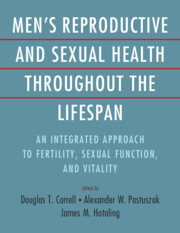 Men's Reproductive and Sexual Health Throughout the Lifespan
Men's Reproductive and Sexual Health Throughout the Lifespan from Section 4 - Laboratory Evaluation and Treatment of Male Infertility
Published online by Cambridge University Press: 06 December 2023
Human spermatogonial stem cells (hSSCs), the only type of germline stem cells in adult men, are responsible to ensure lifetime-long sperm production in men after sex maturation. As the starting point of spermatogenesis, this cell type delicately balances its self-renewal and differentiation, which is essential for spermatogenesis to proceed continuously. A deep and systematic understanding of hSSCs is critical for treating testis-related pathology such as male infertility and testicular germ cell tumor. In this chapter, we provide a systematic review of our previous and current understanding of hSSCs, as well as the advancement of ex vivo systems to culture human germline. Ultimately, the successful establishment of an hSSC-based human germline culture system will not only greatly benefit the study of human germ cell biology by serving as a useful platform, but also provide potential therapeutic options to treat male infertility and preserve fertility for childhood cancer patients.
To save this book to your Kindle, first ensure no-reply@cambridge.org is added to your Approved Personal Document E-mail List under your Personal Document Settings on the Manage Your Content and Devices page of your Amazon account. Then enter the ‘name’ part of your Kindle email address below. Find out more about saving to your Kindle.
Note you can select to save to either the @free.kindle.com or @kindle.com variations. ‘@free.kindle.com’ emails are free but can only be saved to your device when it is connected to wi-fi. ‘@kindle.com’ emails can be delivered even when you are not connected to wi-fi, but note that service fees apply.
Find out more about the Kindle Personal Document Service.
To save content items to your account, please confirm that you agree to abide by our usage policies. If this is the first time you use this feature, you will be asked to authorise Cambridge Core to connect with your account. Find out more about saving content to Dropbox.
To save content items to your account, please confirm that you agree to abide by our usage policies. If this is the first time you use this feature, you will be asked to authorise Cambridge Core to connect with your account. Find out more about saving content to Google Drive.